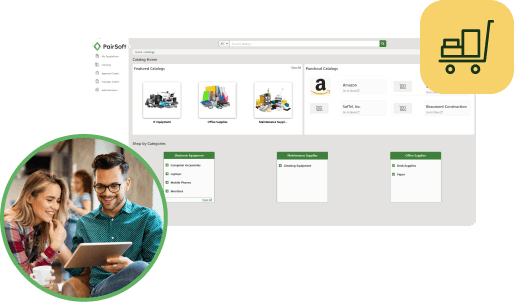Cost reduction is a perennial goal of most procurement professionals. In the 2017 Deloitte Global Chief Procurement Officer Survey, fully 84% of CPOs ranked cost reduction as their highest priority.
Where should you be focusing your energies to lower procurement costs? Here we offer five ways to save in the procurement process.
1. Streamline requisition process
Manual-based requisition processes create and require an enormous amount of overhead to function. By moving to an electronic procurement (eProcurement) solution, you can eliminate the manual tasks and workflows involved and automate the process—saving both time and money.
When you make the requisition process simple, quick, and intuitive, people are more likely to use it, instead of seeking workarounds. Mobile apps that allow employees to initiate requisitions from their phones or tablets are one way to make it easy, and the same apps enable managers to view and approve requisitions while on the go.
By setting different approval routings for different size purchases and different roles within the organization, you can achieve the right balance between control and expediency.
When you streamline the requisition process, you reduce the inherent overhead in the procurement process and encourage employees to use requisitions, which saves the company money by bringing more spending under your direct control.
2. Consolidate buying power
The same Deloitte survey found that consolidating spend is the lever CPO’s expect to deliver the most value in the coming year. By centralizing your spending with the consistent use of requisitions, you gain visibility into company spending—including what are you buying, when, and from whom, and that visibility gives you negotiating power.
In addition to negotiating better volume pricing, simply having fewer suppliers can lead to significant savings, including fewer vendors to vet and set up in your systems, fewer contracts to negotiate and monitor, fewer invoices to process, fewer checks to cut, and lower shipping costs.
3. Monitor vendor contracts
Entering into purchasing contracts with your vendors is a smart idea.
Essentially a master purchase order, a vendor contract establishes an agreement between the two of you, covering details including items, pricing, terms, and shipping methods.
Contracts are valuable to both you and your vendors as they can mitigate any misunderstandings, and build convenient mutually-beneficial relationships.
eProcurement solutions provide the mechanisms to build, use, and monitor vendor contracts. By providing a central contract repository, the software makes it easier to identify overlapping or conflicting terms, ensuring continuing compliance, and identifying the potential for volume discounts.
By allowing you to create requisitions and then purchase orders referencing the contract, eProcurement solutions track the committed amounts against a contract, even before the goods are received. You can also establish alerts and approval workflows if the contracted quantity or dollar amounts are exceeded.
In short, vendor contracts save money by enforcing negotiated terms, ensuring you’re getting the most out of your vendor relationships.
4. Purchase from guided buying catalogs
You can eliminate the need for employees to search and shop for various items on their own by setting up guided buying catalogs where most lower-value purchases can be placed in an online directory using preferred suppliers. Over time, various one-off purchases can be identified and added to the catalog thereby supporting your efforts to moving items from unmanaged to managed.
Guided buying catalogs save time by minimizing data entry tasks, and help control costs by directing purchases to existing vendors with negotiated prices.
5. Bring more spend under direct control
You’ve heard the adage—you can’t manage what you can’t measure. This saying certainly holds true in the procurement department.
Spending that “breaks the rules” by bypassing your requisition and purchase order system, often through unvetted suppliers, is referred to as maverick spending—and it can be quite costly. How does maverick spending grow?
- Employees believe that the purchase is too small to matter
- No formal process in place for smaller transactions or the existing process is too cumbersome
- Management is focused on large spend items and doesn’t enforce spending rules
eProcurement solutions save money by keeping the requisition process and associated approvals straightforward, sensible, and easy to use, so employees are more likely to follow the process. It means you’ll bring more spend under direct control where is measurable and manageable.
How much could you be saving?
Lowering overhead and purchasing costs are a primary goal for procurement professionals, and eProcurement software is an excellent tool to help reach that goal.
Curious to know how much could you be saving? Check out our Procure-to-Pay Calculator to see what your manual systems are costing you, and how automating procurement processes can generate significant and measurable savings.







